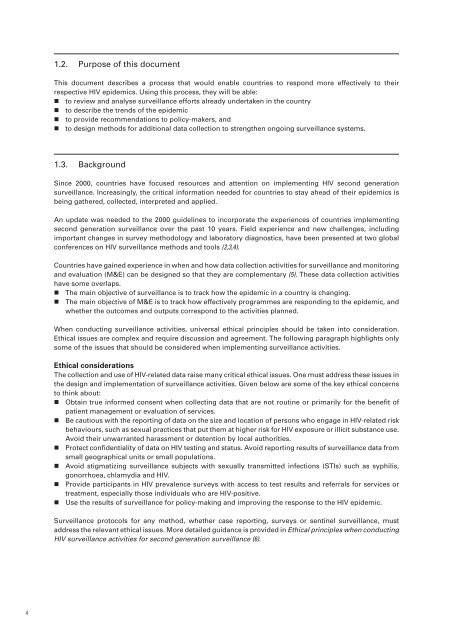Guidelines for second generation HIV surveillance - World Health ...
Guidelines for second generation HIV surveillance - World Health ...
Guidelines for second generation HIV surveillance - World Health ...
Create successful ePaper yourself
Turn your PDF publications into a flip-book with our unique Google optimized e-Paper software.
1.2. Purpose of this document<br />
This document describes a process that would enable countries to respond more effectively to their<br />
respective <strong>HIV</strong> epidemics. Using this process, they will be able:<br />
• to review and analyse <strong>surveillance</strong> ef<strong>for</strong>ts already undertaken in the country<br />
• to describe the trends of the epidemic<br />
• to provide recommendations to policy-makers, and<br />
• to design methods <strong>for</strong> additional data collection to strengthen ongoing <strong>surveillance</strong> systems.<br />
1.3. Background<br />
Since 2000, countries have focused resources and attention on implementing <strong>HIV</strong> <strong>second</strong> <strong>generation</strong><br />
<strong>surveillance</strong>. Increasingly, the critical in<strong>for</strong>mation needed <strong>for</strong> countries to stay ahead of their epidemics is<br />
being gathered, collected, interpreted and applied.<br />
An update was needed to the 2000 guidelines to incorporate the experiences of countries implementing<br />
<strong>second</strong> <strong>generation</strong> <strong>surveillance</strong> over the past 10 years. Field experience and new challenges, including<br />
important changes in survey methodology and laboratory diagnostics, have been presented at two global<br />
conferences on <strong>HIV</strong> <strong>surveillance</strong> methods and tools (2,3,4).<br />
Countries have gained experience in when and how data collection activities <strong>for</strong> <strong>surveillance</strong> and monitoring<br />
and evaluation (M&E) can be designed so that they are complementary (5). These data collection activities<br />
have some overlaps.<br />
• The main objective of <strong>surveillance</strong> is to track how the epidemic in a country is changing.<br />
• The main objective of M&E is to track how effectively programmes are responding to the epidemic, and<br />
whether the outcomes and outputs correspond to the activities planned.<br />
When conducting <strong>surveillance</strong> activities, universal ethical principles should be taken into consideration.<br />
Ethical issues are complex and require discussion and agreement. The following paragraph highlights only<br />
some of the issues that should be considered when implementing <strong>surveillance</strong> activities.<br />
Ethical considerations<br />
The collection and use of <strong>HIV</strong>-related data raise many critical ethical issues. One must address these issues in<br />
the design and implementation of <strong>surveillance</strong> activities. Given below are some of the key ethical concerns<br />
to think about:<br />
• Obtain true in<strong>for</strong>med consent when collecting data that are not routine or primarily <strong>for</strong> the benefit of<br />
patient management or evaluation of services.<br />
• Be cautious with the reporting of data on the size and location of persons who engage in <strong>HIV</strong>-related risk<br />
behaviours, such as sexual practices that put them at higher risk <strong>for</strong> <strong>HIV</strong> exposure or illicit substance use.<br />
Avoid their unwarranted harassment or detention by local authorities.<br />
• Protect confidentiality of data on <strong>HIV</strong> testing and status. Avoid reporting results of <strong>surveillance</strong> data from<br />
small geographical units or small populations.<br />
• Avoid stigmatizing <strong>surveillance</strong> subjects with sexually transmitted infections (STIs) such as syphilis,<br />
gonorrhoea, chlamydia and <strong>HIV</strong>.<br />
• Provide participants in <strong>HIV</strong> prevalence surveys with access to test results and referrals <strong>for</strong> services or<br />
treatment, especially those individuals who are <strong>HIV</strong>-positive.<br />
• Use the results of <strong>surveillance</strong> <strong>for</strong> policy-making and improving the response to the <strong>HIV</strong> epidemic.<br />
Surveillance protocols <strong>for</strong> any method, whether case reporting, surveys or sentinel <strong>surveillance</strong>, must<br />
address the relevant ethical issues. More detailed guidance is provided in Ethical principles when conducting<br />
<strong>HIV</strong> <strong>surveillance</strong> activities <strong>for</strong> <strong>second</strong> <strong>generation</strong> <strong>surveillance</strong> (6).<br />
4
















